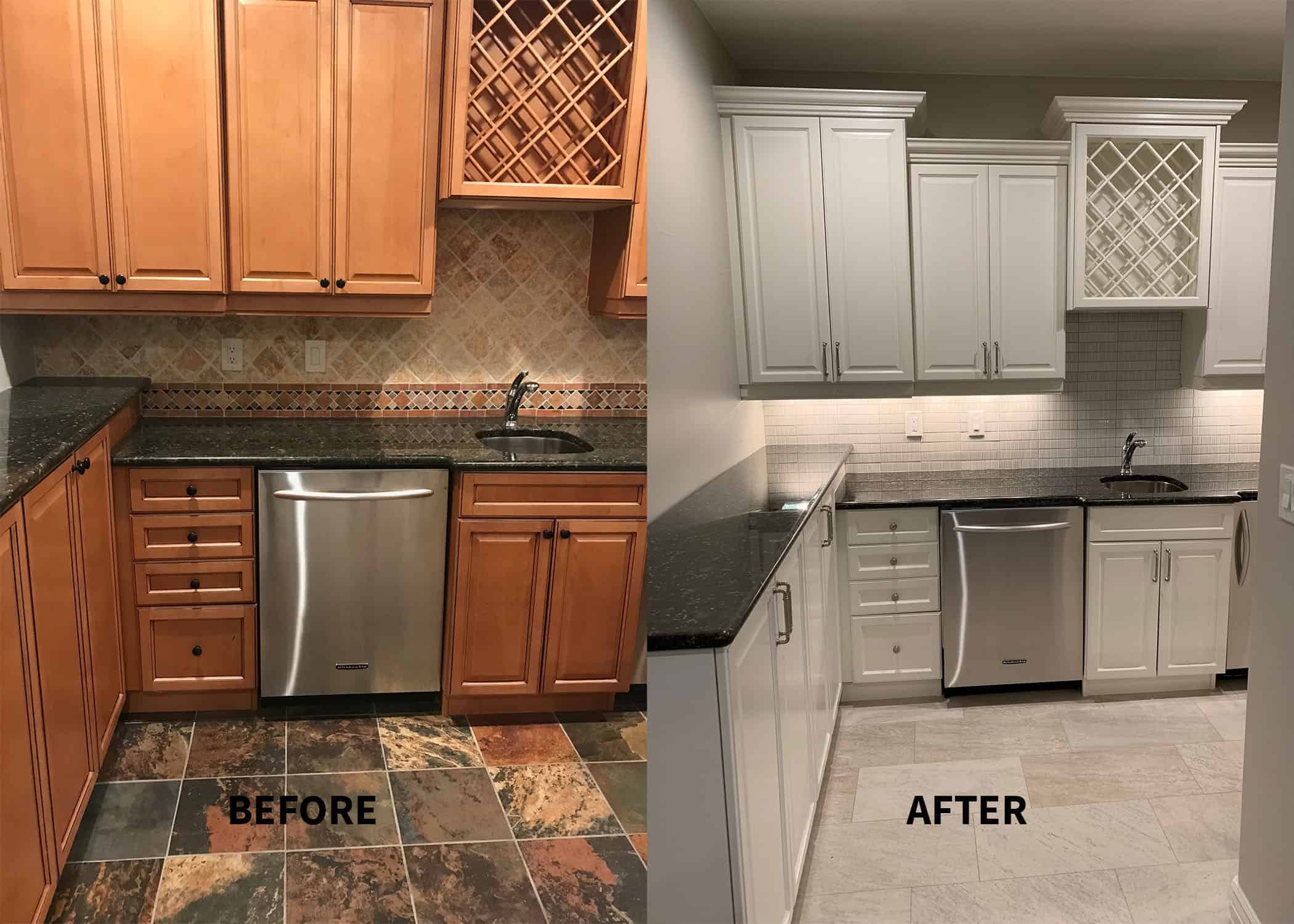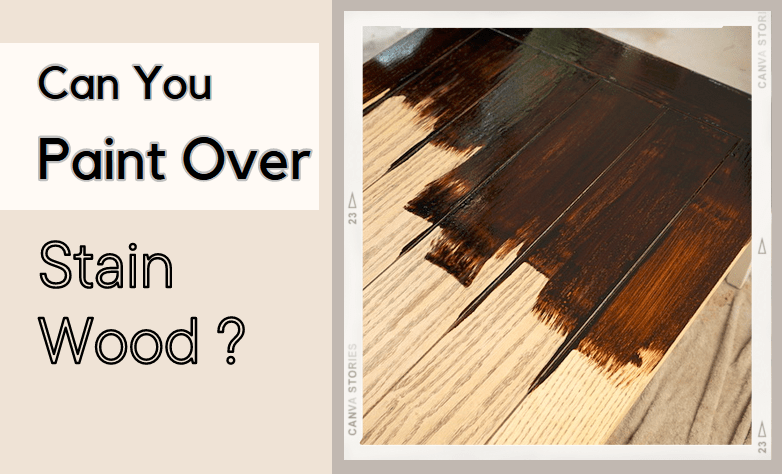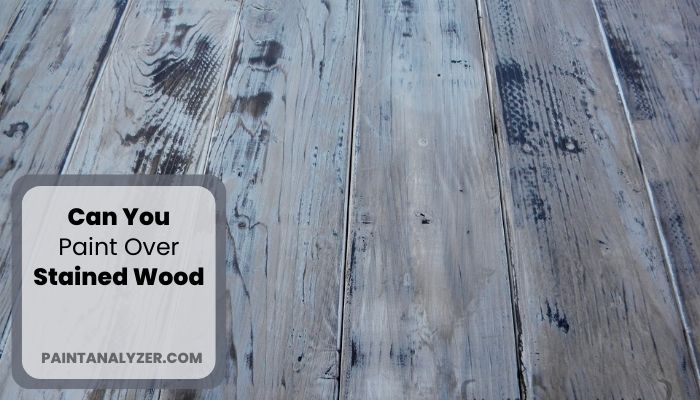Assessing the Stain and Wood Condition: Can You Paint Over Stained Wood Cabinets

Before diving into the painting process, it’s crucial to understand the type of stain on your cabinets and the condition of the wood itself. This will determine the best approach for prepping the surface for paint adhesion.
Types of Wood Stains and Their Impact on Paint Adhesion
Wood stains come in two main types: oil-based and water-based. Both types can affect paint adhesion, but in different ways. Oil-based stains penetrate deeper into the wood, creating a more durable finish. However, they can also create a barrier that makes it difficult for paint to adhere properly. Water-based stains, on the other hand, tend to sit on the surface of the wood, making it easier for paint to bond. However, they may not be as durable as oil-based stains.
Identifying the Type of Stain
There are a few ways to determine if your stain is oil-based or water-based:
- Smell Test: Oil-based stains often have a strong, oily odor, while water-based stains typically have a milder, less pungent smell.
- Water Test: Apply a drop of water to an inconspicuous area of the stained wood. If the water beads up, the stain is likely oil-based. If the water is absorbed, the stain is likely water-based.
- Manufacturer’s Information: Check the label or product information for the stain. It should indicate whether it is oil-based or water-based.
Sanding the Wood Surface
Sanding is a crucial step in preparing stained wood for painting. It helps to create a smooth, even surface that promotes better paint adhesion.
- Remove Glossy Finishes: If the stain has a glossy finish, sanding will help to create a rougher surface that the paint can grip onto.
- Even Out Uneven Surfaces: Sanding can also help to smooth out any uneven surfaces, such as scratches or dents, that may be present on the wood.
- Remove Old Paint: If there are layers of old paint on the cabinets, sanding can help to remove them and create a fresh surface for painting.
Identifying and Addressing Wood Damage
Before painting, it’s important to assess the condition of the wood. Look for any signs of damage, such as scratches, dents, or warping.
- Scratches and Dents: Minor scratches and dents can be filled with wood filler. For deeper damage, consider using a wood patch or replacing the damaged section.
- Warping: Warping can be caused by moisture or temperature changes. If the warping is minor, you may be able to straighten it by applying heat or moisture. For more severe warping, you may need to replace the affected cabinet doors or panels.
Preparing the Cabinets for Painting

You’ve assessed the condition of your stained cabinets and are ready to transform them with a fresh coat of paint. Now it’s time to prepare them for a flawless finish. Proper preparation is crucial for a long-lasting and beautiful paint job.
Cleaning the Cabinets
Before you start sanding, it’s essential to thoroughly clean your cabinets to remove any grease, grime, or dust that could interfere with the paint adhesion.
- Remove the Cabinet Doors and Drawers: This allows you to clean and sand each surface individually, making the process more efficient and thorough.
- Use a Degreaser: Apply a degreaser to the cabinet surfaces using a clean cloth. This will remove any built-up grease or oil.
- Scrub with a Soft-Bristled Brush: Use a soft-bristled brush to scrub the surfaces, paying attention to corners and crevices.
- Rinse Thoroughly: Rinse the surfaces with clean water and allow them to dry completely before proceeding to the next step.
Sanding the Cabinets
Sanding is essential to create a smooth surface for the paint to adhere to. It also helps to remove any imperfections or unevenness that might show through the paint.
- Start with Coarse Grit Sandpaper: Begin with 80-grit sandpaper to remove any rough spots or old paint.
- Progress to Finer Grit: Gradually move to finer grit sandpaper, such as 120-grit and then 220-grit, to create a smooth finish.
- Sand in the Direction of the Wood Grain: Sanding in the direction of the wood grain will prevent scratches and ensure a smooth, even finish.
- Dust Thoroughly: After sanding, use a tack cloth to remove any dust particles.
Materials Needed for Painting
Gather the necessary materials before you begin painting to ensure a smooth and efficient process.
- Primer: Primer is essential for creating a smooth, even surface for the paint to adhere to. Choose a primer specifically designed for wood and stains.
- Paint: Select a high-quality paint that is suitable for cabinets. Consider using a paint that is specifically designed for kitchen cabinets, as it will be more durable and resistant to wear and tear.
- Paint Brushes and Rollers: Choose brushes and rollers that are appropriate for the size and shape of your cabinets.
- Painter’s Tape: Use painter’s tape to protect areas that you don’t want to paint, such as walls, countertops, or hardware.
- Drop Cloths: Protect your floors and surrounding areas from paint spills.
- Paint Thinner: Use paint thinner to clean your brushes and rollers after painting.
Applying Primer
Primer is essential for creating a smooth, even surface for the paint to adhere to. It helps to seal the wood and prevent the stain from bleeding through the paint.
- Stir the Primer: Stir the primer thoroughly to ensure that it is evenly mixed.
- Apply a Thin Coat: Apply a thin, even coat of primer to the cabinets using a brush or roller.
- Avoid Puddling: Be careful not to apply too much primer, as this can cause puddling and uneven coverage.
- Let the Primer Dry Completely: Allow the primer to dry completely before applying the paint.
Choosing and Applying Paint

You’ve prepped your cabinets, and now it’s time to choose the perfect paint and apply it with care. The right paint will make your cabinets look stunning and last for years.
Types of Paint, Can you paint over stained wood cabinets
Choosing the right paint is crucial for achieving a durable and beautiful finish. Oil-based and latex paints are the most common options for cabinets.
- Oil-Based Paint: Oil-based paints offer excellent durability, a smooth finish, and resistance to moisture and stains. They dry slowly, allowing for more time to correct mistakes, but they also emit strong fumes and require mineral spirits for cleanup.
- Latex Paint: Latex paints are water-based, making them easier to clean up with soap and water. They dry quickly and emit fewer fumes than oil-based paints. While latex paints are less durable than oil-based paints, they offer excellent adhesion and are available in a wide range of colors and finishes.
Paint Finishes
The paint finish you choose will determine the look and feel of your cabinets.
- Gloss: Gloss finishes offer the highest shine and are the most durable, making them ideal for high-traffic areas. They are easy to clean but can show imperfections more readily.
- Semi-Gloss: Semi-gloss finishes provide a moderate shine and good durability, making them a popular choice for cabinets. They are easier to clean than matte finishes and offer a good balance of durability and aesthetics.
- Matte: Matte finishes have a flat, non-reflective appearance. They are good at hiding imperfections but are less durable and more challenging to clean than glossier finishes.
Choosing the Right Paint Color and Sheen
Consider the overall style of your kitchen and your personal preferences when selecting a paint color and sheen.
- Color: Lighter colors can make a space feel larger, while darker colors can create a cozy atmosphere.
- Sheen: If you want a classic look, consider a semi-gloss or gloss finish. For a more modern or rustic look, a matte or eggshell finish might be more appropriate.
Applying Paint
Now it’s time to get your hands dirty and apply the paint.
- Prepare the Area: Cover your floors and countertops with drop cloths to protect them from paint splatters.
- Open Windows and Doors: Ensure good ventilation to minimize paint fumes.
- Prime the Cabinets: Apply a primer specifically designed for cabinets. This will help the paint adhere better and provide a smooth, even surface.
- Apply the First Coat of Paint: Use a high-quality paintbrush or roller for even coverage. Apply thin coats of paint, allowing each coat to dry completely before applying the next.
- Sand Between Coats: Lightly sand between coats with fine-grit sandpaper to smooth out any imperfections and create a smoother finish.
- Apply Additional Coats: Apply as many coats as needed to achieve the desired coverage and opacity.
- Clean Up: Once the paint is dry, clean your brushes or rollers with the appropriate solvent (water for latex paint, mineral spirits for oil-based paint).
Can you paint over stained wood cabinets – You bet you can paint over stained wood cabinets! It’s a great way to give your kitchen a fresh look without the cost of replacing them. If you’re feeling adventurous, you might even consider adding some wood cabinet open shelves to create a more open and airy feel.
Just remember to properly prep the cabinets before painting to ensure a smooth and long-lasting finish.
You bet you can paint over stained wood cabinets! It’s a fantastic way to give your kitchen a fresh look. But remember, preparation is key. Make sure to thoroughly clean the cabinets before you start painting, using a gentle cleaner specifically designed for cleaning painted wood cabinets.
This will ensure the paint adheres properly and lasts longer. Once your cabinets are clean and dry, you’re ready to unleash your creativity and give them a whole new look!
